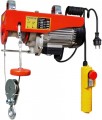Operation speed
The speed of movement of the load provided by the hoist / winch without an external movable block (data on working with the block are given separately). Specified only for models with electric or hydraulic drive (see "Device"); for a manual drive, it makes no sense to specify the speed, since, in fact, it depends only on the user's capabilities. Also note that we are talking about working with cargo; idle speed can be specified in the specifications additionally.
When choosing according to this indicator, it should be taken into account that a higher speed (with the same carrying capacity) requires a more powerful drive, which accordingly increases the price and energy consumption of the unit, and in hydraulic models, it puts forward increased requirements for the power of the hydraulic pump. In addition, speed is not always desirable from a purely practical point of view — for accurate and smooth movement of goods, low speeds are more convenient. And with carrying capacity, this parameter is inversely related: with the same engine power, higher speed will mean less tractive effort. In light of all this, it makes sense to specifically look for a “fast” model only if this moment is of fundamental importance — for example, if you often have to move a large amount of cargo in a limited time, or if we are talking about an auto winch for off-road racing, where on every second counts.
As for specific indicators, the “high-speed” models include models where t...his indicator is 10 m / min or more. The slowest units give out less than 1 m / min — these are mainly auto winches, in which, due to this, it was possible to achieve good traction with a relatively low-power (and therefore light and compact) engine.
Also note that the use of a movable block (see "Complete set") reduces the speed of work by exactly half. So knowing the unit's own speed, you can evaluate the speed of working with the unit, even if it is not indicated separately in the characteristics.
Speed with block
The maximum speed of movement of the load provided by the hoist / winch when using an external movable block. Specified only for models with electric or hydraulic drive (see "Device"); for a manual drive, it makes no sense to specify the speed, since, in fact, it depends only on the user's capabilities. We also clarify that we are talking about working with cargo; idle speed can be specified in the specifications additionally.
For the block itself, see "Complete set". Here we note that the speed of work with such a device inevitably turns out to be half as much as without it (if work without a block is generally allowed by the design of the unit). Accordingly, if the most “high-speed” modern hoists / winches themselves give out about 14 – 16 m / min, then with blocks, even in them, the speed will not exceed 7 – 8 m / min.
When choosing by speed (whether with or without a block), you should keep in mind that speed has not only advantages, but also downsides. Firstly, with the same carrying capacity, it requires a more powerful — and therefore more expensive, heavy and high consumption — engine. Secondly, an increase in speed can adversely affect the accuracy and smoothness of movement. So it makes sense to specifically look for a “fast” model only if this moment is of fundamental importance — for example, if you often have to move a large amount of cargo in a limited time, or if we are talking about an auto winch for off-road racing, where every second.
Power consumption
Nominal power absorbed by the motor of the electrical unit (see "Drive").
The torque developed by the engine directly depends on the energy consumption. Thus, higher power allows high tractive forces and/or high working speeds (depending on the gearbox used, see "Gear ratio"). On the other hand, a powerful motor will have more weight and dimensions, and it will consume more energy — the latter can be critical when running on a car battery, when the energy supply is limited, and can also put forward additional requirements for connection features. And high tractive effort can be achieved with a relatively weak motor on a good gearbox. Accordingly, it is worth specifically looking for a unit with high power in the case when a combination of good load capacity with high speed is important. And even in these cases, it is worth looking first of all at the speed and load capacity, and assessing the connection requirements by the power consumption.

